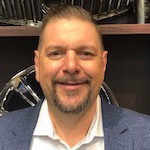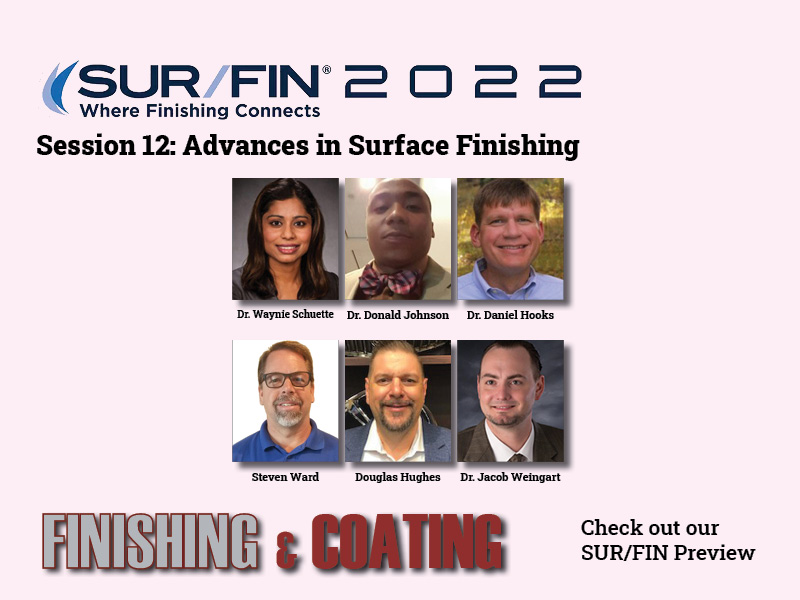Session 12 at the NASF SUR/FIN Technical Conference will be on “Advances in Surface Finishing.”
Here are the abstracts for the presentations on June 8. Please visit www.nasfsurfin.com for information on registering for the event:
Session 12: Advances in Surface Finishing
Session Chairs Dan Hooks, Los Alamos Nat’l Labs, and Bill Nebiolo, REM Surface Engineering
1:30 – 2:00: Application of Schiff Base Chemistry to Surface Passivation of Plated Steels — Dr. Waynie Schuette, Boeing Corp.
 Waynie SchuetteHexavalent chromium (Cr6+) containing sealers are primarily used to enhance corrosion protection of metal plating, Al anodizing and other sacrificial layers when exposed to corrosive atmospheric environments. The need to reduce or eliminate the use of Cr6+ containing anodizing and passivating sealing solutions remains a top priority for the DoD to reduce risks associated with environmental, human health, and compliance issues. Many Cr6+ free corrosion inhibitors and coating systems have been researched and implemented to various extents over the last several decades. Most corrosion inhibitors can be classified as inorganic or organic based on their molecular formula. The focus of this study is organic inhibitors, specifically those containing a Schiff base (SB) or an azomethine functional group (--RC=N--). Boeing Research and Technology (BR&T) has discovered a unique functionality of these SB inhibitors that enables high polarization resistance of Al when exposed to chloride-containing corrosive media. Twenty- three different corrosion inhibitors with the Schiff base functionality were synthesized and characterized using fourier-transform infrared spectroscopy (FTIR) and nuclear magnetic resonance spectroscopy (NMR). Corrosion inhibition of the organic inhibitors were evaluated using polarization resistance and potentiodynamic scans of the metal surface. Electrochemical corrosion resistance performance of the inhibitors were ranked using inhibitor efficiency and the corrosion rate of the metal was calculated using Faraday’s law and the corrosion current from potentiodynamic scans. BR&T is partnering with the Missouri University of Science and Technology (Missouri S&T) and the Naval Air Systems Command (NAVAIR) to develop and mature organic Schiff base (SB) containing passivating solutions for zinc (Zn), zinc-nickel (ZnNi), cadmium (Cd) plating.
Waynie SchuetteHexavalent chromium (Cr6+) containing sealers are primarily used to enhance corrosion protection of metal plating, Al anodizing and other sacrificial layers when exposed to corrosive atmospheric environments. The need to reduce or eliminate the use of Cr6+ containing anodizing and passivating sealing solutions remains a top priority for the DoD to reduce risks associated with environmental, human health, and compliance issues. Many Cr6+ free corrosion inhibitors and coating systems have been researched and implemented to various extents over the last several decades. Most corrosion inhibitors can be classified as inorganic or organic based on their molecular formula. The focus of this study is organic inhibitors, specifically those containing a Schiff base (SB) or an azomethine functional group (--RC=N--). Boeing Research and Technology (BR&T) has discovered a unique functionality of these SB inhibitors that enables high polarization resistance of Al when exposed to chloride-containing corrosive media. Twenty- three different corrosion inhibitors with the Schiff base functionality were synthesized and characterized using fourier-transform infrared spectroscopy (FTIR) and nuclear magnetic resonance spectroscopy (NMR). Corrosion inhibition of the organic inhibitors were evaluated using polarization resistance and potentiodynamic scans of the metal surface. Electrochemical corrosion resistance performance of the inhibitors were ranked using inhibitor efficiency and the corrosion rate of the metal was calculated using Faraday’s law and the corrosion current from potentiodynamic scans. BR&T is partnering with the Missouri University of Science and Technology (Missouri S&T) and the Naval Air Systems Command (NAVAIR) to develop and mature organic Schiff base (SB) containing passivating solutions for zinc (Zn), zinc-nickel (ZnNi), cadmium (Cd) plating.
1:00 – 1:30: Pixelated Nickel-Copper Scintillator Screens with Improved Efficiency for X-Ray Computed Tomography — Dr. Donald Johnson, Los Alamos National Laboratory
 Dr. Donald JohnsonThis study explored copper electroplating onto pure pixelated nickel screens; this study explored screen morphology as a function of deposition time. In order to determine optimal process parameters, this study focused on bath chemistry composition, electroplating parameters, optical imaging and small-scale diffusion bonding experiments. Monolithic scintillator screens for x-ray computing tomography (CT) applications are widely used in the aerospace industry to certify dense parts and ensure quality. These screens are able to convert ionizing radiation (i.e. gamma rays, x-rays) into visible light to generate an image with a camera. The ability for these screens to interact with x-rays depend on the density of the screen composition; here, metallic materials possess high densities within the range of 7 – 10 grams/cm3. Pixelated metallic screens can enable more interactions at pixelated sites resulting in less time to acquire an image and reduce x-ray exposure to the part. Over the past few years, we have worked with several types of electroplated coatings to improve the performance of pixelated aperture arrays. Nickel-Copper alloys are applicable to this application space due to its bondable intermetallic diffusion and formation of a solid solution. By electroplating nickel screens with copper and stacking them, we are able to diffusion bond these screens together under high vacuum conditions, allowing us to improve our CT capability.
Dr. Donald JohnsonThis study explored copper electroplating onto pure pixelated nickel screens; this study explored screen morphology as a function of deposition time. In order to determine optimal process parameters, this study focused on bath chemistry composition, electroplating parameters, optical imaging and small-scale diffusion bonding experiments. Monolithic scintillator screens for x-ray computing tomography (CT) applications are widely used in the aerospace industry to certify dense parts and ensure quality. These screens are able to convert ionizing radiation (i.e. gamma rays, x-rays) into visible light to generate an image with a camera. The ability for these screens to interact with x-rays depend on the density of the screen composition; here, metallic materials possess high densities within the range of 7 – 10 grams/cm3. Pixelated metallic screens can enable more interactions at pixelated sites resulting in less time to acquire an image and reduce x-ray exposure to the part. Over the past few years, we have worked with several types of electroplated coatings to improve the performance of pixelated aperture arrays. Nickel-Copper alloys are applicable to this application space due to its bondable intermetallic diffusion and formation of a solid solution. By electroplating nickel screens with copper and stacking them, we are able to diffusion bond these screens together under high vacuum conditions, allowing us to improve our CT capability.
2:30 – 3:00: Understanding Metal Additive Manufactured Surfaces — Dr. Daniel Hooks, Los Alamos National Laboratory
 Dr. Dan HooksMetal additive manufacturing (AM) is being pursued as manufacturing technique in order to shorten development cycles and reduce cost through rapid iteration and agile design. Metal AM allows for designs that were not previously possible, optimizing the balance between mechanical strength and weight. However, rough as-built surfaces do not meet engineering specifications, with roughness measurements between Sa = 5 – 60 mm. Furthermore, depending on the build angle the surface roughness varies widely within a single part. These rough surfaces result in different surface morphology and chemistry compared to other manufacturing methods which has a direct impact on the susceptibility to localized corrosion and mechanical performance. This variation is also amplified depending on the machine used to build the material. We have extensively characterized the surface roughness, and corrosion response of AM 316L stainless steel (SS) that has been built on different machines which result in significantly different surface properties. Our team is also developing environmentally friendly surface finishing techniques to reduce the surface roughness to meet specifications, increase corrosion performance, and drastically reduce the part-to-part variations. We have used optical methods to measure the surface roughness of as-built AM 316L SS, A20x (AM aluminum alloy), and Ti6-4. Aqueous and atmospheric corrosion measurements have been performed on 316L SS. Finally, EDS/SEM measurements reveal there is significant chemical segregation on the surface of the as-built material; however, surface treatment methods being developed by the group have been shown to remove this layer. Post-processing surface treatments result in a more homogeneous surface and improve the performance of the material.
Dr. Dan HooksMetal additive manufacturing (AM) is being pursued as manufacturing technique in order to shorten development cycles and reduce cost through rapid iteration and agile design. Metal AM allows for designs that were not previously possible, optimizing the balance between mechanical strength and weight. However, rough as-built surfaces do not meet engineering specifications, with roughness measurements between Sa = 5 – 60 mm. Furthermore, depending on the build angle the surface roughness varies widely within a single part. These rough surfaces result in different surface morphology and chemistry compared to other manufacturing methods which has a direct impact on the susceptibility to localized corrosion and mechanical performance. This variation is also amplified depending on the machine used to build the material. We have extensively characterized the surface roughness, and corrosion response of AM 316L stainless steel (SS) that has been built on different machines which result in significantly different surface properties. Our team is also developing environmentally friendly surface finishing techniques to reduce the surface roughness to meet specifications, increase corrosion performance, and drastically reduce the part-to-part variations. We have used optical methods to measure the surface roughness of as-built AM 316L SS, A20x (AM aluminum alloy), and Ti6-4. Aqueous and atmospheric corrosion measurements have been performed on 316L SS. Finally, EDS/SEM measurements reveal there is significant chemical segregation on the surface of the as-built material; however, surface treatment methods being developed by the group have been shown to remove this layer. Post-processing surface treatments result in a more homogeneous surface and improve the performance of the material.
3:00 – 3:30: Nucleation, Growth and Grain Structure Control of Electrodeposited Graded Density Alloys — Dr. Dan Hooks, Los Alamos National Laboratory
 Dr. Dan HooksWe are developing methods to create thick (mm) electrodeposited films of alloys with graded composition and density. We are designing deposition processes to dynamically control nucleation and growth to investigate correlations between grain structure and dynamic properties. We are also characterizing the properties of the films, both pure and alloyed, as a function of processing conditions. Gold is of interest as a model system in high-pressure and dynamic research because of its inert character, especially because purity, defects, and grain structure can be carefully controlled. Further, because of its potential as a graded density alloy, baseline characterization is important. Gold has complete solid solubility with silver, and similar deposition chemistries. Using several techniques, including control of several process variables, we have produced films of graded composition in silver and gold. To broaden the potential for high-pressure research and other applications, similar techniques can be applied to any material that can be electrodeposited, and we will discuss graded compositions of other materials. The grain structure of the deposit can have an influence on properties, so in addition to composition, we have been researching deposition parameters to control this structure. Controlling nucleation and growth is critical to influencing ultimate grain structure in the deposit, so we have also determined and applied some basic nucleation and growth parameters for our systems. Although there are several well-known aspects, nucleation and growth are some of the most fundamental rate dependent processes in many chemical and physical transformations and remain among the most difficult to measure and predict. Assessing and predicting nucleation and growth, and rate-dependent processes, such as first-order phase transitions, are widely applicable to a multitude of practical applications. In the context of metal deposition for alloy systems, characterizing and modelling nucleation and growth can lead to an ability to design compositionally varied alloys with controlled grain structures. Therefore, we also performed investigations of nucleation and growth in our systems. We present a study of electroplated films with compositional gradients and varied microstructures up to thicknesses of several mm for gold and silver, with discussion of other alloys in development. We relate the composition and grain structure to dynamic response. Constant potential and pulsed plating techniques were used to create a variety of grain structures, including high aspect ratio columnar grains. These structures and their dynamic response were compared. Microscopy was correlated with mechanical characterization of the films at several rates and scales, and impact characteristics are compared and related to growth techniques and their relation to nucleation and growth parameters. With this baseline of properties, we then present initial results of dynamic experiments using graded density impactors, which show good uniformity over large areas.
Dr. Dan HooksWe are developing methods to create thick (mm) electrodeposited films of alloys with graded composition and density. We are designing deposition processes to dynamically control nucleation and growth to investigate correlations between grain structure and dynamic properties. We are also characterizing the properties of the films, both pure and alloyed, as a function of processing conditions. Gold is of interest as a model system in high-pressure and dynamic research because of its inert character, especially because purity, defects, and grain structure can be carefully controlled. Further, because of its potential as a graded density alloy, baseline characterization is important. Gold has complete solid solubility with silver, and similar deposition chemistries. Using several techniques, including control of several process variables, we have produced films of graded composition in silver and gold. To broaden the potential for high-pressure research and other applications, similar techniques can be applied to any material that can be electrodeposited, and we will discuss graded compositions of other materials. The grain structure of the deposit can have an influence on properties, so in addition to composition, we have been researching deposition parameters to control this structure. Controlling nucleation and growth is critical to influencing ultimate grain structure in the deposit, so we have also determined and applied some basic nucleation and growth parameters for our systems. Although there are several well-known aspects, nucleation and growth are some of the most fundamental rate dependent processes in many chemical and physical transformations and remain among the most difficult to measure and predict. Assessing and predicting nucleation and growth, and rate-dependent processes, such as first-order phase transitions, are widely applicable to a multitude of practical applications. In the context of metal deposition for alloy systems, characterizing and modelling nucleation and growth can lead to an ability to design compositionally varied alloys with controlled grain structures. Therefore, we also performed investigations of nucleation and growth in our systems. We present a study of electroplated films with compositional gradients and varied microstructures up to thicknesses of several mm for gold and silver, with discussion of other alloys in development. We relate the composition and grain structure to dynamic response. Constant potential and pulsed plating techniques were used to create a variety of grain structures, including high aspect ratio columnar grains. These structures and their dynamic response were compared. Microscopy was correlated with mechanical characterization of the films at several rates and scales, and impact characteristics are compared and related to growth techniques and their relation to nucleation and growth parameters. With this baseline of properties, we then present initial results of dynamic experiments using graded density impactors, which show good uniformity over large areas.
3:30 – 4:00: Arrow Space Anodizing Rinsewater Recycling Options — Steven Ward, Water Innovations
Overview of alternative aerospace anodizing rinse water recycling technologies including capital and operating cost comparative advantages and other considerations
4:00 – 4:30: Ammonia-Free Electroless Nickel Strike — Douglas Hughes, MacDermid Enthone
 Doug HughesThis presentation will discuss MacDermid Enthone‘s latest innovation, an ammonia-free electroless nickel strike. This next generation EN strike is a low temperature ammonia-free and Pb/Cd free solution. The process is formulated to meet ELV, RoHS, and WEEE directives as well as simplify waste-water handling and minimize harmful odor during operation. The presentation will provide a comparison of the key operational aspects of ammonia-free vs. conventional strike processes, discuss deposit properties, and highlight waste treatment and EH&S benefits of the new technology. Electroless nickel strikes play an important role in maximizing efficiencies and extending the operational life of electroless nickel production solutions. However, the nature of current technologies and their reliance on high concentrations of ammonia to achieve desired deposit properties present their own set of challenges relevant to worker safety and effective waste-water treatment. Additionally, most current electroless nickel strike formulations utilize Pb & Pb/Cd stabilization packages that are contradictory to industry environmental sustainability initiatives.
Doug HughesThis presentation will discuss MacDermid Enthone‘s latest innovation, an ammonia-free electroless nickel strike. This next generation EN strike is a low temperature ammonia-free and Pb/Cd free solution. The process is formulated to meet ELV, RoHS, and WEEE directives as well as simplify waste-water handling and minimize harmful odor during operation. The presentation will provide a comparison of the key operational aspects of ammonia-free vs. conventional strike processes, discuss deposit properties, and highlight waste treatment and EH&S benefits of the new technology. Electroless nickel strikes play an important role in maximizing efficiencies and extending the operational life of electroless nickel production solutions. However, the nature of current technologies and their reliance on high concentrations of ammonia to achieve desired deposit properties present their own set of challenges relevant to worker safety and effective waste-water treatment. Additionally, most current electroless nickel strike formulations utilize Pb & Pb/Cd stabilization packages that are contradictory to industry environmental sustainability initiatives.
4:30 – 5:00: Enhancing Corrosion Protection with the Development of a Clear Cr (III) Passivate for Aluminum Alloys — Dr. Jacob Weingart, Columbia Chemical
 Dr. Jacob WeingartPassivation continues to be a robust method of extending the corrosion protection of substrates. As a result of environmental compliance and safety concerns, demand for trivalent chromium passivates for aluminum continues to increase. This presentation will provide a brief discussion on growth segments in the aluminum market and then examine the development of a clear aluminum passivate that achieves excellent corrosion protection and enhanced durability. Performance factors such as passivate appearance and operating range will be discussed, as well as salt spray data, post treatment applications, and benefits of trivalent passivation as a pretreatment before lacquering, powder coating, or adhesive application.
Dr. Jacob WeingartPassivation continues to be a robust method of extending the corrosion protection of substrates. As a result of environmental compliance and safety concerns, demand for trivalent chromium passivates for aluminum continues to increase. This presentation will provide a brief discussion on growth segments in the aluminum market and then examine the development of a clear aluminum passivate that achieves excellent corrosion protection and enhanced durability. Performance factors such as passivate appearance and operating range will be discussed, as well as salt spray data, post treatment applications, and benefits of trivalent passivation as a pretreatment before lacquering, powder coating, or adhesive application.



































